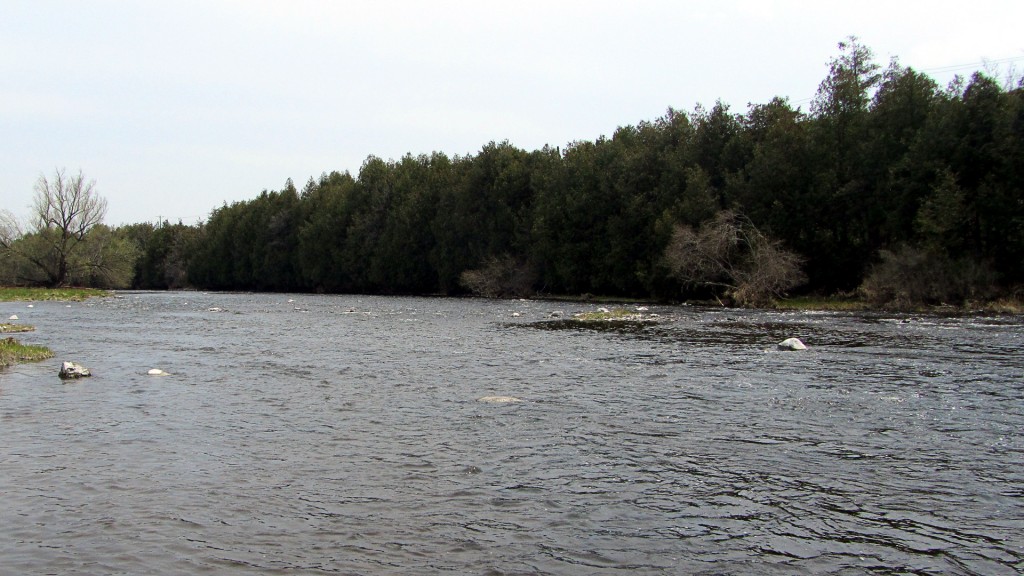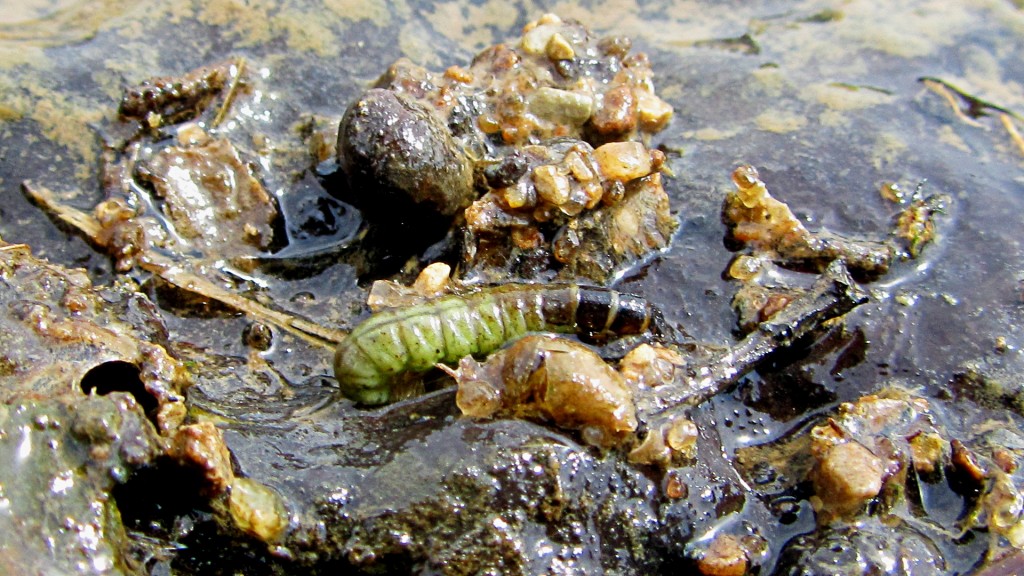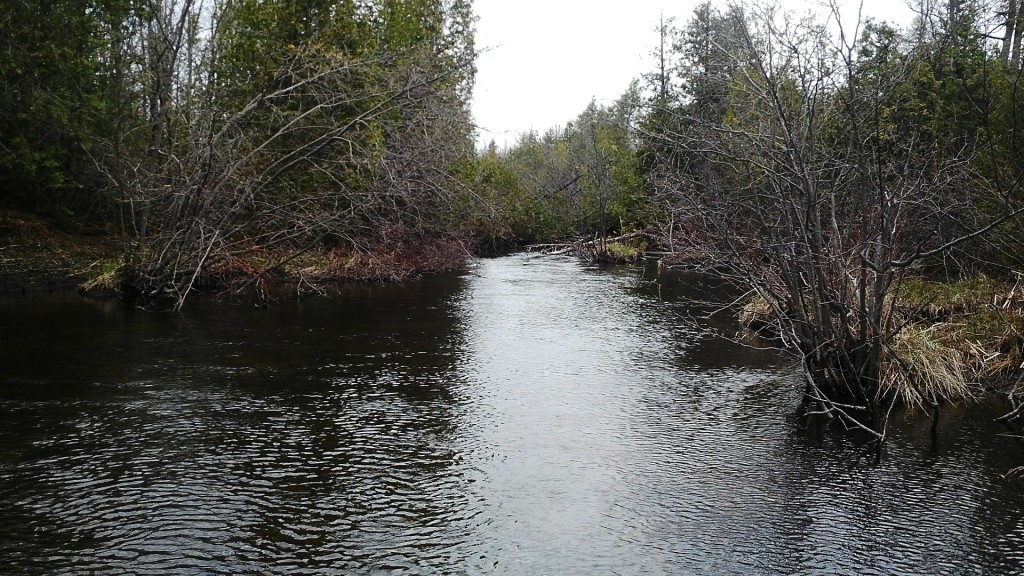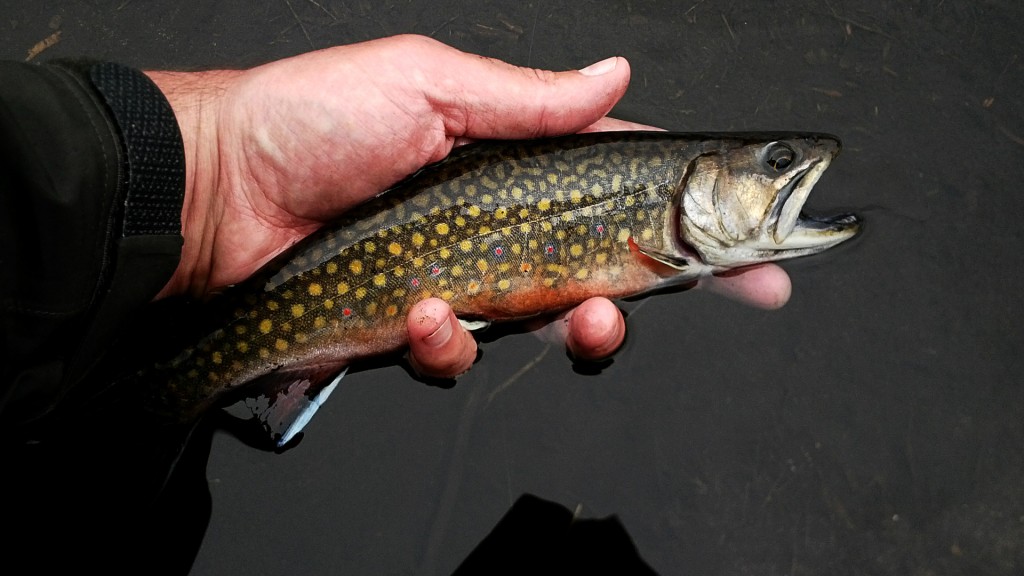There have been only a handful of fishable days on the upper Grand River so far this season due to high flows. The first of these (the second day of the season) was apparently somewhat productive, but after the water levels rose again for a while and then fell last week, the Browns seemed to have completely shut down. On the couple days I fished it last week, not only did I get skunked, but so did every other angler I met on the river. I stopped by Wilson’s one day after fishing and learned that every angler who visited the shop that day experienced the same results.
Last week was a reminder of just how mysterious the Grand River can be. It varies between one of the easiest and most difficult rivers to fish at times. I wonder how much of this has to do with it being a stocked river. I was actually watching In The Loop earlier this week and they were fishing stocked rivers and discussing how difficult they can sometimes be due to the different feeding habits and behaviours of stocked fish over wild fish. There are other factors at play on the Grand as well though, not the least of which is the fact that it’s a tailwater fishery and highly susceptible to the will of Shand Dam. At times like this though, I’m not sure whether to call it challenging, or impossible. There are some nearby freestone wild trout rivers that, while having much less dense trout populations and being quite challenging, are certainly more stable and predictable.
One angler that I talked to on the Grand guessed that the problem was a lack of food in the river: that perhaps the high flows had washed everything downstream. However, every rock I picked up was teeming with caddis larva. I couldn’t entice a strike with these nymphs in various styles, sizes and depths, nor with any other nymphs or streamers I had at my disposal.
Thankfully, Brook Trout have been a bit more cooperative than the Browns, which is to be expected for this time of year I suppose. If you fly fish, I’m sure you’ve driven over your share share of bridges, wondering what the tiny streams and ditches below them might contain. Well, I finally decided to stop at one such bridge last week, after driving past it dozens of times prior. My gut feel had always been that this little stream likely wouldn’t contain much and would be a waste of time.
Before setting up my rod, I walked down to the little body of water to scout it out. It was crystal clear and quite shallow – I figured if there were any fish in there, I should be able to spot them. After a couple minutes of carefully sneaking around and being unable to see any signs of life, I headed back to the car and debated whether to fish. I decided that I aught to at least give it a try, otherwise I’d keep wondering every time I drove past it. I setup my 3 weight, grabbed a box of flies and tippet and headed back down to the stream.
Although it wasn’t dry fly season, I figured shallow water, small stream and brookies were a good enough combination to fish one anyway. Being careful to not spook any fish, I crouched a few feet back from the bank and began casting my trusty red humpy to the top of a decent looking run. There was little flow, so getting a good drift wasn’t a problem. After a number of drifts without any strikes, my hopes were beginning to sink. I moved a few steps downstream, took another cast and was startled when a nice sized fish slammed my dry fly. It’s not that the fish was all that large, but I was expecting at most a 5-6″ brookie, if anything at all. The fish I pulled in on this tiny stream with my 3 weight far exceeded my expectations!
I’d never been so excited to catch a Brook Trout of this size. I spent the next couple hours exploring up and downstream, involving some serious bushwhacking – and hooking into a few more smaller brookies. Looking back, it seems inexplicable that I hadn’t stopped to fish this stream before. I don’t think I’ll be making the same mistake in the future. It’s so rewarding to find these types of little spots and figure them out all on your own. It certainly made up for my lacklustre fishing on the Grand.
The next week is filled with predictions of rain and thunderstorms, so unless the weather man is wrong again, there’s a good chance the Grand will be back in trouble. Might be a good time to hit some more small streams for Brookies, or to try out my new membership to Glen Haffy.





I like your blog. I got a 9’8 rod for 60$ from a guy at work and 25$ in flies from a place in Guelph- now I can be on the Eramosa river near Rockwood , from my door, in under 5 minutes. Perfect for the busy dad of 3 little fellas. – – your blog helps guide my fly selections. I get some bites-
I am quite happy to be out in my rubber boots and regular backpack I’ll get fancier gear in time- for now, if I catch fish or not, it’s great to be out. I’m sure the skill will come and so will the fish. Happy fishing yourself- if you pass by this way, I’ll get you a java and show you to the river. – PR
Hey PR, nothing wrong with starting out with cheap gear. I fished with a starter rod for almost 10 years before upgrading to more expensive rods and I dealt with cheap leaky waders and limited fly selections for quite some time as well. It really is all about just getting out there and enjoying the river. Guelph is a nice location for easy access to a large number of rivers – I’m not far from there myself. Good luck this season!
It doesn’t matter what your gear costs as long as it’s comfortable enough for the amount of time you’re out there; and it casts properly to the distance you need it to. I’ve been using cheap gear for the last 4-5 years and I catch plenty of fish. Caught 15+ fish over 15″ this summer. A 30 something inch resident rainbow, 3x 24″ browns on the grand. A few 18″ and a few 20″ browns on the grand. 6x 10″ Brookies on the credit. All on a $90 echo rod with a $30 fly line and a $90 reel which I use for steel head and summer resident fishing. with $120 rubber waders right through the summer. What matters most is techinque and presentation. Just make sure your leader is not too short or too long and keep switching through flies. Remember the ones that work for you and cycle through them every time before trying something new unless you know what’s hatching. Best of luck!